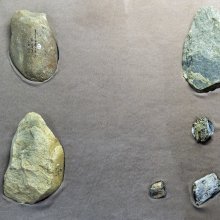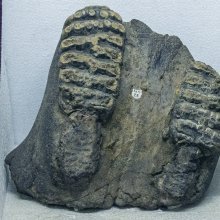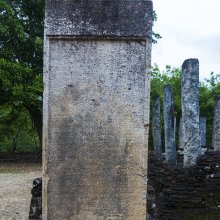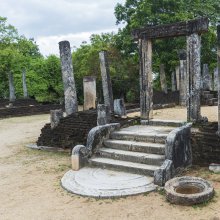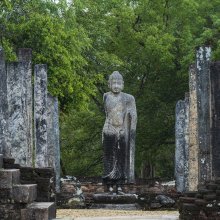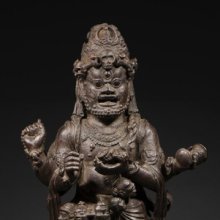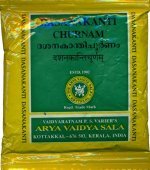Tooth, Teeth: 4 definitions
Introduction:
Tooth means something in Hinduism, Sanskrit, biology. If you want to know the exact meaning, history, etymology or English translation of this term then check out the descriptions on this page. Add your comment or reference to a book if you want to contribute to this summary article.
Images (photo gallery)
(+49 more images available)
In Hinduism
Purana and Itihasa (epic history)
Source: Shodhganga: Elements of Art and Architecture in the Trtiyakhanda of the VisnudharmottarapuranaTeeth (and other body parts) were traditionally coloured by professional artists, as part of the “sixty four kinds of Art”, according to the Kamasutra of Vatsyayana.—Cf. the Sanskrit Daśanavasanāṅgarāga.—Indian tradition, basically includes sixty four Art forms are acknowledged. The history of Indian Art covers approximately five thousand years which presents a rich and almost continuous record. The references of sixty four kinds of Kala (कला, kalā) are found in the Bhagavatapurana, Shaiva-Tantras, Kamasutra of Vatsyayana etc.

The Purana (पुराण, purāṇas) refers to Sanskrit literature preserving ancient India’s vast cultural history, including historical legends, religious ceremonies, various arts and sciences. The eighteen mahapuranas total over 400,000 shlokas (metrical couplets) and date to at least several centuries BCE.
Gitashastra (science of music)
Source: Shodhganga: Elements of Art and Architecture in the Trtiyakhanda of the Visnudharmottarapurana (gita)The Teeth (in Sanskrit: Danta) refers to one of various Organs of Utterance (sthāna), according to Bhattojidīkṣita in his Siddhāntakaumudī.—During the practise of Vocal Music, the proper production of the concerned sound is always considered as very important. Sthāna or ucchāraṇasthāna is the place of articulation of sound. Bhattojidīkṣita in his Siddhāntakaumudī said about ten kinds of sthāna (i.e., the organs of utterance), e.g., danta (teeth).
Gitashastra (गीतशास्त्र, gītaśāstra) refers to the ancient Indian science of Music (gita or samgita), which is traditionally divided in Vocal music, Instrumental music and Dance (under the jurisdiction of music). The different elements and technical terms are explained in a wide range of (often Sanskrit) literature.
Shilpashastra (iconography)
Source: Shodhganga: Elements of Art and Architecture in the Trtiyakhanda of the Visnudharmottarapurana (shilpa)The Teeth are denoted by the Sanskrit term Danta, and represents one of the various body parts whose Measurements should follow the principles of ancient Indian Painting (citra), according to the Viṣṇudharmottarapurāṇa, an ancient Sanskrit text which (being encyclopedic in nature) deals with a variety of cultural topics such as arts, architecture, music, grammar and astronomy.—In the third part of the Viṣṇudharmottarapurāṇa, chapters 35th to 43rd are dedicated to the Painting of different portraits of different kinds of men and women. The measurement of almost all the body parts that should be maintained in a picture have been presented here. For example, the Teeth (danta) should be 12 aṅgulas.

Shilpashastra (शिल्पशास्त्र, śilpaśāstra) represents the ancient Indian science (shastra) of creative arts (shilpa) such as sculpture, iconography and painting. Closely related to Vastushastra (architecture), they often share the same literature.
Biology (plants and animals)
Source: Google Books: CRC World Dictionary (Regional names)1) Tooth in India is the name of a plant defined with Morus alba in various botanical sources. This page contains potential references in Ayurveda, modern medicine, and other folk traditions or local practices It has the synonym Morus australis Poir. (among others).
2) Tooth is also identified with Morus australis It has the synonym Morus bombycis var. tiliifolia Koidz. (etc.).
Example references for further research on medicinal uses or toxicity (see latin names for full list):
· Botanical Magazine, or ‘Flower-Garden Displayed’ (Tokyo) (1915)
· Acta Biologica Cracoviensia, Series Botanica (1989)
· Botanical Magazine, or ‘Flower-Garden Displayed’ (Tokyo) (1917)
· Descr. Mûriers (1855)
· Notulae ad Plantas Asiaticas (1854)
· Flora de la región del Parque Nacional Amboró Bolivia (2004)
If you are looking for specific details regarding Tooth, for example pregnancy safety, chemical composition, side effects, extract dosage, diet and recipes, health benefits, have a look at these references.

This sections includes definitions from the five kingdoms of living things: Animals, Plants, Fungi, Protists and Monera. It will include both the official binomial nomenclature (scientific names usually in Latin) as well as regional spellings and variants.
See also (Relevant definitions)
Starts with: Boar tooth, Monkey tooth, Tooth cup, Tooth-brush, Tooth-brush bush, Tooth-pick, Toothache berry, Toothache plant, Toothache tree, Toothbrush tree, Toothed bur clover, Toothed burclover, Toothed maidenplum, Toothed medic, Toothed medick, Toothed spurge, Toothed-leaved pelargonium, Tootho, Toothpick ammi.
Query error!
Full-text (+2334): Danta, Dasana, Dantadhavana, Dantakashtha, Radana, Rada, Damshtra, Rajadanta, Dantaka, Dantura, Dantya, Dvija, Dadha, Dantaharsha, Jambha, Sudat, Jatadanta, Dantadanti, Adhidanta, Halu.
Relevant text
Search found 416 books and stories containing Tooth, Teeth; (plurals include: Tooths, Teeths). You can also click to the full overview containing English textual excerpts. Below are direct links for the most relevant articles:
World Journal of Pharmaceutical Research
Preparation and evaluation of herbal tooth powder < [2019: Volume 8, September issue 10]
Dantadhavana an ayurvedic approach in maintance of oral health-a review < [2021: Volume 10, July special issue 9]
A conceptual study of mukhaswastha and mukhagat vyadhi < [2021: Volume 10, November issue 13]
International Ayurvedic Medical Journal
Primary tooth eruption - an ayurvedic overview < [2019, Issue 1, January]
The role of dantadhavana (tooth brushing) to promote oral health < [2023, Issue 08. August]
Krimidanta w.s.r to dental caries and its management in ayurveda: a conceptual study < [2017, Issue II February,]
Journal of Indian Society of Periodontology
Paramolar concrescence and periodontitis < [Volume 17 (issue 3), May-Jun 2013]
Pathological tooth migration corrected by periodontal therapy alone. < [Volume 17 (issue 4), Jul-Aug 2013]
Intentional replantation of periodontally compromised hopeless tooth < [Volume 17 (issue 5), Sep-Oct 2013]
The Malaysian Journal of Medical Sciences
Common Dental Anomalies in Cleft Lip and Palate Patients < [Volume 22 (issue 2), Mar-Apr 2015]
Compound Odontoma in Anterior Mandible—A Case Report < [v.24(3): 1–103 2017 May]
Tooth Wear Prevalence and Sample Size Determination : A Pilot Study < [v.15(4): 1–71 2008 Oct]
AYU (Journal of Research in Ayurveda)
Comparison between the effect of commercially available chemical teeth whitening paste and teeth whitening paste containing ingredients of herbal origin on human enamel < [Volume 39 (2); 2018 (Apr-Jun)]
Role of Laksha Churna and Madhu Pratisarana after ultrasonic scaling in the management of Dantasharkara (dental calculus): An open-label, standard controlled randomized clinical trial < [Volume 41 (3); 2020 (Jul-Sep)]
Effect of Ayurvedic herbs on control of plaque and gingivitis: A randomized controlled trial < [Volume 32 (4); 2011 (Oct-Dec)]
Folk medicine of rayalaseema region, andhra pradesh: i dental protectors < [Volume 15 (issue 1), Jul-Sep 1995]
Role of triphala in the management of peridontal disease < [Volume 17 (issue 2), Oct-Dec 1997]
Ethnobotanical aspects of some plants of aravalli hills in north gujarat < [Volume 21 (issue 4), Apr-Jun 2002]
Related products
(+12 more products available)
